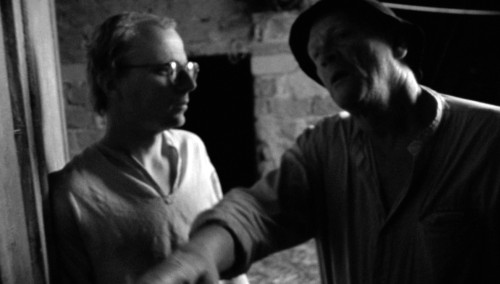Świniopas
Swineherd
Angelehnt an Hans Christian Andersens gleichnamiges Märchen, in dem sich ein Prinz als Schweinehirte verkleidet, um die Oberflächlichkeit einer Prinzessin aufzudecken, ist es hier der Schweinehirte, der das swastikageschmückte Geschirr aus dem Sumpf zieht. Er, der sich am Rande der Dorfgemeinschaft befindet, verrichtet neben seinen Hilfstätigkeiten für einen brutalen Bauern außerdem Botendienste für dessen Tochter, die sich in eine einfache Magd und Feldarbeiterin verliebt hat. Dieser scheint auch der Hirte selbst zugetan. Die tagtägliche Gleichförmigkeit des bäuerlichen Lebens wird durch einen fahrenden Musiker gestört, der zum stillen Beobachter wird. Doch durch ihn bricht etwas auf. Der Mann wird gefangen genommen und gefoltert, in einer surrealen Wendung verwandelt er sich in eine Kamera, die buchstäblich durch den Dreck gezogen wird. Unerwartet durchbrechen dokumentarische Bilder von Lehrlingen an einer technischen Schule das Geschehen, ihr Zeithorizont bleibt jedoch unklar. Am Ende gelingt zur Musik von Elvis Presley eine Flucht im alten Rettungswagen – das hat etwas von Godards À bout de souffle. (Claudia Slanar)
The swineherd’s scenes and the beautiful cinematography by Sasnal and Aleksander Trafas evoke another film of pastoral horrors with an animal at its center: Robert Bresson’s Au hasard Balthazar, with its ever-savaged donkey. Nevertheless, the poverty and misery is more straightforward in Sasnal’s film, and the charged imagery more radical as well: an image of a movie camera being dragged through the streets like a man, a night-time party of drunken revelry in the fields where violence is weirdly portended, and the torture of the musician. A surprising montage toward the end of the film, which selfconsciously and symbolically brings the story abruptly into the present day […] (Quinn Latimer, Frieze)
Director's Biography
ANKA SASNAL, born in 1973 in Tarnów in Poland, studied Polish literature and gender studies. As a screenwriter, editor, and filmmaker, she lives in Kraków together with Wilhelm Sasnal, who was also born in Tarnów in 1972 and studied architecture and painting.
WILHELM SASNAL attracted international attention as a visual artist with a series of solo and group exhibitions in renowned international galleries and art institutions with paintings, comic books, drawings, photographs, and videos. From the first joint film project onwards, significant characteristics of their artistic collaboration are already visible: the intensive focus on language, texts, and literary models, which they transform into an image language that suits them. An explicit political stance can be noted in their films – thematically Anka and Wilhelm Sasnal circle around the current state of Polish society, rising xenophobia, the relationship of Polish society to the Catholic church, and especially the recent Polish past during the Second World War. A dystopian worldview, although not so much a pessimistic one – as they say themselves – may certainly be attributed to their work, along with an undisguised interest in the “dark” side of human beings. Anka and Wilhelm Sasnal are no strangers to the festival audience in Linz, as they have already been represented in the festival program twice in the past. In 2012, they won the main prize with It Looks Pretty from a Distance, which premiered in Rotterdam, and then returned with Parasite in 2014.
// Films at CROSSING EUROPE Film Festival 2017
// Co-directed films: Słońce, to słońce mnie oślepiło (The Sun, the Sun Blinded Me, 2016), Huba (Parasite, 2014; CE’14), Aleksander (2013, doc), Z daleka widok jest piękny (It Looks Pretty from a Distance, 2011; CE’12), Świniopas (Swineherd, 2008)
// Films by Wilhelm Sasnal: Afternoon of a Faun (2015, short), Columbus (2014, short), Inhuman Hunger (2014, short), Kacper (2010, short), Europa (2007, short), Brazil (2005, short), Marfa (2005, short)
WILHELM SASNAL attracted international attention as a visual artist with a series of solo and group exhibitions in renowned international galleries and art institutions with paintings, comic books, drawings, photographs, and videos. From the first joint film project onwards, significant characteristics of their artistic collaboration are already visible: the intensive focus on language, texts, and literary models, which they transform into an image language that suits them. An explicit political stance can be noted in their films – thematically Anka and Wilhelm Sasnal circle around the current state of Polish society, rising xenophobia, the relationship of Polish society to the Catholic church, and especially the recent Polish past during the Second World War. A dystopian worldview, although not so much a pessimistic one – as they say themselves – may certainly be attributed to their work, along with an undisguised interest in the “dark” side of human beings. Anka and Wilhelm Sasnal are no strangers to the festival audience in Linz, as they have already been represented in the festival program twice in the past. In 2012, they won the main prize with It Looks Pretty from a Distance, which premiered in Rotterdam, and then returned with Parasite in 2014.
// Films at CROSSING EUROPE Film Festival 2017
// Co-directed films: Słońce, to słońce mnie oślepiło (The Sun, the Sun Blinded Me, 2016), Huba (Parasite, 2014; CE’14), Aleksander (2013, doc), Z daleka widok jest piękny (It Looks Pretty from a Distance, 2011; CE’12), Świniopas (Swineherd, 2008)
// Films by Wilhelm Sasnal: Afternoon of a Faun (2015, short), Columbus (2014, short), Inhuman Hunger (2014, short), Kacper (2010, short), Europa (2007, short), Brazil (2005, short), Marfa (2005, short)
Tribute 2017
Anka Sasnal, Wilhelm Sasnal
Polen / Schweiz 2008
black and white
85 Minuten
OmeU
Drehbuch Wilhelm Sasnal
Kamera Wilhelm Sasnal, Aleksander Trafas
Schnitt Wilhelm Sasnal
Ton/Sounddesign Igor Kłaczyński
Mit Przemysław Czepurko, Karolina Kominek, Zbigniew Kosowski, Bartek Materka, Marta Ojrzyńska, Feliks Szajnert, Krzysztof Zarzecki
Produzent*innen Wilhelm Sasnal (PL), Hauser & Wirth (CH)
Produktion
Hauser & Wirth Limmatstrasse 270 8005 Zurich, Switzerland zurich@hauserwirth.com www.hauserwirth.com
Österreichpremiere
Weltpremiere / World Premiere Hauser & Wirth, Zurich, 2009
Premierenstatus / Premiere Status
Austrian Premiere




